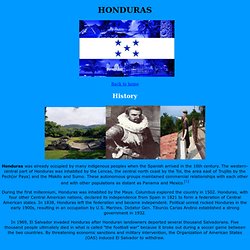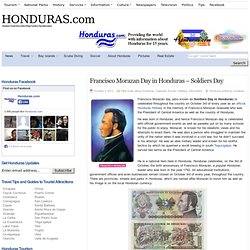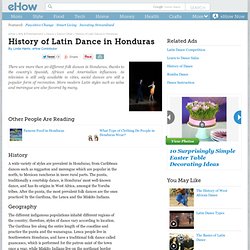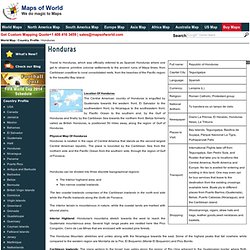

Jose Antonio Velasquez - Biography. Jose Antonio Velasquez, Honduran (1906 - 1983) José Antonio Velasquez was born on February 8, 1906 in Charity, a small town in the department of Valle, in the country of Honduras. 1931, José Antonio Velásquez married Raquel Maradiaga, who bore him six children: Jose Antonio, Julio Cesar Tulio Enrique, Aída Raquel, Queen Virginia and Ruth Elia.

After the death of his parents, Caridad Velásquez abandoned and moved to the northern coast of Honduras in search of better living conditions, that once offered the banana companies. Subsequently, Velasquez became a barber, played alternately work with the telegraph. It was precisely this trade, which led to Velasquez as an employee to move to San Antonio de Oriente, a small place, located about 30 kilometers from Tegucigalpa, capital of Honduras. Velasquez came to love so much to this town, so this became the inspiration for most of his works. Honduras. Back to home History Honduras was already occupied by many indigenous peoples when the Spanish arrived in the 16th century.

The western-central part of Honduras was inhabited by the Lencas, the central north coast by the Tol, the area east of Trujillo by the Pech(or Paya) and the Miskito and Sumo. These autonomous groups maintained commercial relationships with each other and with other populations as distant as Panama and Mexico.[1] Honduran People and Culture. Time to meet the Hondurans!

In this page you'll learn about our food, languages, customs, celebrations, and our rich ethnic diversity. Let's get started with perhaps the most important topic... Food For some unknown reason, the first questions asked about Honduras are about food: "What's the food like? " or "Is it very hot and spicy? ". For flavour, the Honduran chef will rely heavily on spices such as cumin, curry, allspice, and achiote; fresh herbs such as coriander and oregano; and lime juice to give food a very rich flavour.
Honduran food does usually contain meat. Corn Everywhere As in other countries in the area, Honduran food relies heavily on the use of corn (maize) as a basic ingredient. The most common (and perhaps the simplest) example of food made from corn in Latinamerica is the humble corn tortilla. Francisco Morazan Day in Honduras - Soldiers Day - HONDURAS.com. Francisco Morazán day (also known as Soldiers Day in Honduras) is celebrated throughout the country on October 3rd of every year as an official Honduras Holiday in the memory of Francisco Morazan Quesada who was the President of Central America as well as the country of Honduras.

He was born in Honduras, and hence Francisco Morazan day is celebrated with official government events as well as parades put on by many schools for the public to enjoy. Morazan is known for his idealistic views and his attempts to enact them. He was also a person who struggled to maintain the unity of the nation when it was involved in a civil war, but he didn’t succeed in his attempt. He was an able military leader and known for his skillful tactics by which he quashed a revolt brewing in south Tegucigalpa. He served two terms as the President of Central America. He is a national hero here in Honduras. Francisco Morazan on the Five Lempira Honduran currency. Honduras State Symbols, Song, Flags and more. Honduras - Leta McGaffey, Michael Spilling. Hondurans - Introduction, Location, Language, Folklore, Religion, Major holidays, Rites of passage, Relationships, Living conditions.
PRONUNCIATION: hahn-DUR-uhns LOCATION: Honduras POPULATION: 5 million LANGUAGE: Spanish; English; local dialects RELIGION: Roman Catholicism (95 percent); Protestantism (Methodist, Church of God, Seventh-Day Adventist, Moravian, and Assembly of God churches); native religions combined with Christianity.

History of Latin Dance in Honduras. History of Social Dance Dancing is one of the oldest human activities and is found in almost every human society.

A dancer performing solo, whether in... Music of Honduras. The music of Honduras is very varied, Punta is the main "ritmo" de Honduras, to Caribbean music like salsa, merengue, reggae, and reggaeton all widely heard especially in the North, to Mexican rancheras heard in the interior, rural part of the country.

The country's ancient capital of Tegucigalpa is an important center for modern Honduran music, and is home to the College for Fine Arts [1]. Garifuna music[edit] Popular Music[edit] Though American music has produced most of the popular music in modern Honduras, the country has produced several well-known musicians such as: A few famous bands originally from Honduras are: The Dung BeetlesThe Fruit LoopsThe Red BananananananasExtreme Latino Rock! Reggaeton has been popular in the country for many years, and Honduras has emerged as a leading producer of artists.
Raggamofin KillasEl PuebloLos Bohemios Del ReggaetonDJ SlyfoxDJ Sy Music Institutions[edit] Articles[edit] Honduras. Travel to Honduras, which was officially referred to as Spanish Honduras where one get to observe primitive colonial settlements to the ancient ruins of Maya times, from Caribbean coastline to coral consolidated reefs, from the beaches of the Pacific region to the beautiful Bay Island.

Honduras Facts. Honduras was once a sprawling empire that was merged with one of the oldest civilizations - the Mayans.

The Honduras have this little spectacle of ruins, called 'Copan', which is situated in Western Honduras, and goes as far back to 1000 BC. It has now spread to the Peninsula area, and was then a part of Mexico, where the empire was divided in AD 900, among the locals, who are known still today known as 'Hondurans'. The area accounts as the second largest country in South America, and has mountain ranges with coastal plains and river valleys, not to mention a breathtaking coast line that combines the pacific and Caribbean.
You'll find more about these Honduras factoids here, that will also do well for kids to understand and know about. It is good to have knowledge about a place we've never heard of, or always wanted to know about. Honduras. Honduras is a Central American republic that borders Guatemala and El Salvador on the west and Nicaragua on the south with both Caribbean and Pacific coasts.

Honduras's rugged terrain has limited the transportation network and kept the population, which is predominantly rural, relatively isolated. The economy of Honduras is based on agriculture and is one of the least advanced in Central America. Almost wholly mountainous with narrow coastal plains, two major mountain ranges run east to west, dividing Honduras into halves. About 70 percent of the population lives in the mountain valleys. Much of Honduras has a temperate climate. Honduras Facts With these Honduras facts you'll come to understand that this beautiful Caribbean and pacific coastline, holds within itself a rich history, where present day Honduras is just as spectacular and inviting... Honduras map, flag and country information on the Yahoo! Kids World Factbook.
Honduras Travel Information and Travel Guide. Like its neighbors, Honduras is experiencing tremendous changes: an expanding tourist economy (cruise ships in Roatán?!) , a maturing political scene, and the whole globalization thing, including maquilas, free trade agreements – heck, even implementing Daylight Savings Time for the second time. Honduras remains deeply entrenched in a two-front war against gangs and HIV/AIDS. Illegal logging is emerging as another major concern (do you know where that new mahogany chest came from?) And a key issue among Honduras’ growing environmental community. Even so, most Hondurans you’ll meet are very laid back and, while not disinterested, certainly disinclined to make much to-do over politics and world affairs. Honduras today is a place of change, too fast for those who’d like the country to remain ‘undiscovered’, too slow for those frustrated by persistent remnants of the ‘Banana Republic’ days, whether in undue foreign influence or lax enforcement of environmental laws.
Ready to go? Read more. Honduras - GEOGRAPHY. Location and Boundaries Honduras, located at the widest part of the isthmus of Central America, is the second largest Central American republic. The triangular-shaped country has a total area of about 112,000 square kilometers. Honduras capital, history, map, flag, and people. El Salvador - GEOGRAPHY. El Salvador, the smallest Spanish-speaking nation in the Western Hemisphere, is located on the western side of the Central American isthmus.
With an area of 21,041 square kilometers, the country is only slightly larger than Massachusetts. It is roughly rectangular in shape with 515 kilometers of land boundaries and 307 kilometers of coastline on the Pacific Ocean. Culture of Honduras. Honduras is a beautiful country with nature at its lap and the natural beauty are enough to charm anybody and its located at the north central part of Central America. Honduras Culture is similarly vibrant but unique like the country itself and its a democratic constitutional republic.
The ethnic composition are of Mestizo 90%, Amerindian 7%, Black African 2 % and White 1% and the religious composition consists of Roman catholic 97% and Protestant 3%. Honduras Facts: Learn Honduras Facts. Honduras. Custom Search. Honduras Facts. Facts about Honduras. Encyclopedia.com articles about Honduras.